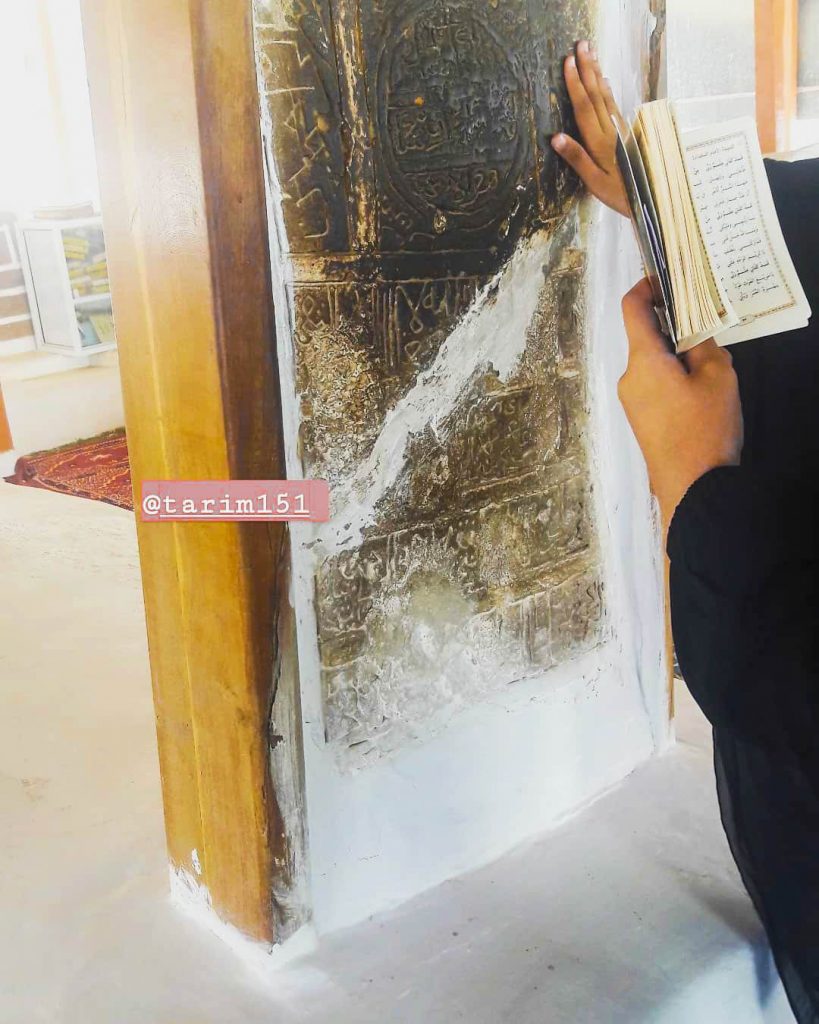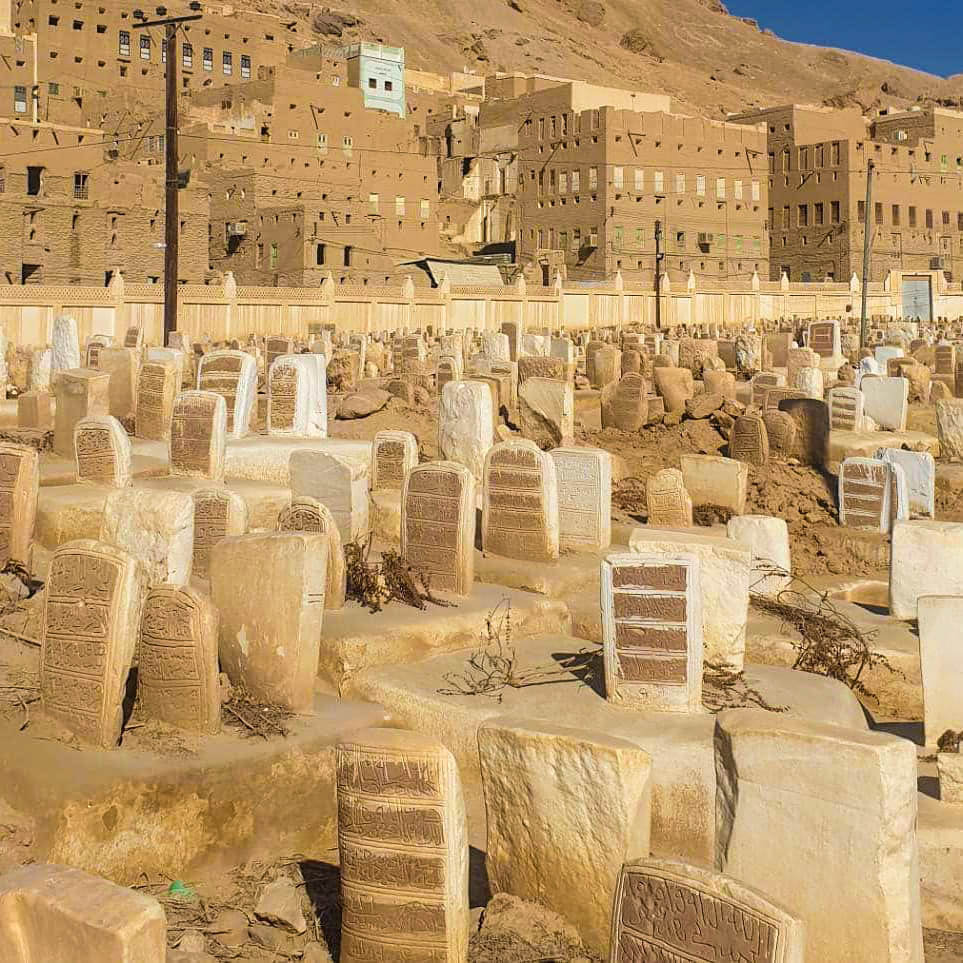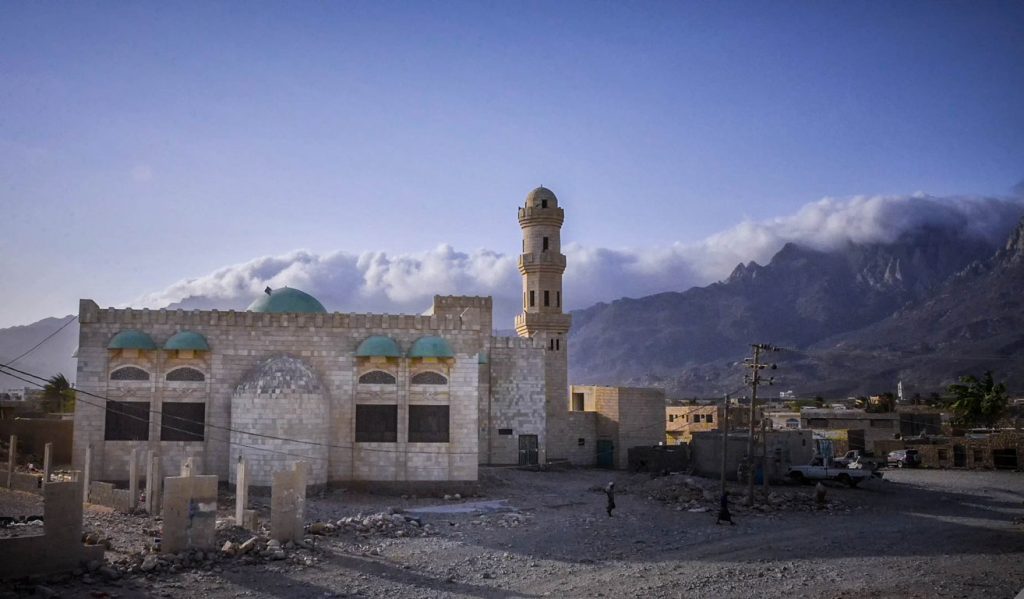Tarim, Yemen
Coordinates: 16.051165, 48.994141
Nearby Places
- Al-Muhdhar Mosque 0.66 Km NE (54°)
- Qasr al-‘Ishshah 0.79 Km NE (53°)
- Tarim, city of Prophets and Saints 1.43 Km NE (60°)
Imam Sayyid Abd Allah ibn Alawi al-Haddad رحمة الله عليه (born in 1634 CE) was a Yemeni Islamic scholar and Awliya Allah. He lived his entire life in the town of Tarim in Yemen’s Valley of Hadramawt and died there in 1720 CE (1132 Hijri). He was an adherent to the Ashari Sunni Creed of Faith (Aqeedah), while in Islamic jurisprudence (Fiqh), he was a Shafi’i.
Early life
Hz. Abdullah رحمة الله عليه was born on Sunday night, 5th Safar, 1044 AH (1634 CE) in al-Subayr, a village on the outskirts of Tarim in Hadramawt. His father was Alawi bin Muhammad al-Haddad, a pious man of taqwa, from the people of Allah. Imam al-Haddad’s paternal grandmother, Salma, was also known to be a woman of gnosis and sainthood. His mother was Salma bint Aidrus bin Ahmad al-Habshi. His maternal great-grandfather, Ahmad al-Habshi, met Imam al-Haddad’s father, prior to Imam al-Haddad’s father, knowing Imam al-Haddad’s mother and he said to Imam al-Haddad’s father “Your children are my children, and there is a blessing in them”. As a Sayyid, his sanctity and direct experience of God are clearly reflected in his writings, including several books, a collection of Sufi letters, and a volume of mystical poetry.
Losing sight at an early age
The Imam was tall and fair-skinned. Smallpox caused him permanent blindness before the age of five. This does not seem to have affected his personality or scholarship, in memorizing the whole Qur’an or even his look, as no scars remained on his face. “In my childhood,” he testifies, “I was never treated like one who didn’t see, neither in walking nor in playing.” He was trained as a religious scholar from a young age, given to very intense worship and spiritual struggle as a child. He also chose the ascetic path, “In the beginning, I spent a long period subsisting on coarse food and wearing rough clothes.”
His Taqwa
Imam al-Haddad رحمة الله عليه would perform recitation a quarter juz (portion) of the Quran practice alone in his youth, prior to the age of 17 in the desert canyons around Tarim. Sometimes he would do this with one of his friends. In Ramadan 1061 A.H (1650 C.E.), while he was still at the age of 17, the Imam entered khalwa (spiritual seclusion) in a zawiya Masjid al-Wujayrah mosque in Tarim. He also married in this same year. He would spend his time in khalwa during the day and then leave to be with his wife at night, at the home of his wife’s family. His servant would lead him to various mosques in Tarim at night, where it is reported he would pray up to 700 Rakat per night.
Among the nicknames of Imam al-Haddad was the axis of invitation and spiritual guidance (Al-Qutb At Dawati wal Irshaad). He was also known as the blacksmith of hearts (Haddad al-Quloob). A possible meaning for this would be that they would take a rusted or corroded piece of metal and transform it into a shiny well-formed piece of metal.
Education
Imam al-Haddad رحمة الله عليه studied with many of the scholars of his time in Hadhramaut, one of them is his father. Before he reached the age of 15, his father advised to memorize a book called al-Irshad, an extremely abridged work in Shafii fiqh, but later requested that he would prefer to study the book Bidayat al-Hidayah (Beginning of Guidance) instead of concentrating on jurisprudence. Amongst the foremost of his other teachers was al-Habib al-Qutb Umar bin Abdul-Rahman al-Attas. Imam Abdul-Rahman al-Attas is known to be the teacher that allowed him to develop some of his spiritual opening as a student.
As a very young man when Imam al-Haddad رحمة الله عليه would recite Sura Yaseen, he would start crying and be overcome with crying. It is believed that his spiritual opening was through Sura Yaseen. He studied Bidayat al-hidayah under the guidance of a scholar, al-Faqih ba-Jubayr. He also studied Ihya ulum al-din (Revival of Religious Sciences) by Imam al-Ghazali رحمة الله عليه under the scholar.
Works and Teachings
Earning his livelihood from the plantations he owned, his life was devoted to teaching and writing. Imam al-Haddad رحمة الله عليه began to teach shortly after he entered khalwa (seclusion). Among the books he taught was Awaarif al-Ma’arif which is a classical work in tasawwuf by Hz. Abu Hafs Umar al-Suhrawardi رحمة الله عليه. He did this for approximately 11 years until 1072 A.H. (1661 C.E.). Even the Sultans of his day received letters of admonition and counsel from him. He spent most of his life in Hadramawt, where he taught Islamic jurisprudence and classical Sufism according to the Ba’ Alawiyya Sufi order (tariqa).
His works revolve around the attainment of certainty (yaqin), the degree of unshakeable faith in Allah and Prophet Muhammad ﷺ. They are void of investigative or dogmatic debates. Furthermore, he does not bring up legal rulings (ahkam fiqhiyya), which would necessitate that his readership is limited to the adherents of his school of law (Shafii). Thus, his works are very well suited, if not purposely designed, for mass readership. His writings are brief because he judged that coming generations would not have time to read large volumes.
‘Yaqin’ is attained by proper practice of the ‘Sunna’ in fulfilling obligatory worships and avoiding prohibitions and sincerity and truthfulness to God. There should be no barriers between the outward forms, the inward essence, and the practical applicability of the Islamic teachings. Thus, whoever has the knowledge, according to Imam al-Haddad رحمة الله عليه, must teach it to those who need it.
He authors several books in the area of Sufism as well as books of dhikr such as the Ratib al-Haddad and Wird al-Lateef. He also authors books such as a ten-volume series of his short treatises, his volume of poetry, a compilation of his sayings, Risaalat al-Mu’awanah (The Book of Assistance), an-Nasaih al-Diniyyah wal-Wasaya al-Imaniyyah (Religious Counsels and Faith-based Advice)
Later life
Imam al-Haddad رحمة الله عليه lived during Islam’s “Period of Decline”, in which its forces of might and beauty seem to have become exhausted. During his life, the British were already accustomed to trading in Yemen, and the Portuguese had captured the island of Socotra, 350 km off the coast. Muslim expansion had virtually come to a halt. Furthermore, his region of Hadramawt witnessed a simply ruinous period during his life. When Imam al-Haddad رحمة الله عليه was twenty-five, Hadramawt was conquered by the Qasimi Zaydis of Upper Yemen. The Hadramis regained their freedom in 1715 CE; the Imam was eighty-one years of age.
Passing Away
Imam al-Haddad رحمة الله عليه passed away in his home in al-Hawi, Tarim on Monday night 7th or 8th Dhu al-Qi’ dah, 1132 AH (1720 C.E.) and buried at Zanbal cemetery in Tarim. His grave is one of the leading destinations many people visited when they do a religious tour to Hadhramaut.
Lineage
Six sons survived imam al-Haddad رحمة الله عليه. His first son was Zainal Abidin, the second son was Hasan who died in Tarim in 1188 AH, the third one was Salim, the fourth one was Muhammad, where his descendants are in Tarim, the fifth one was Alwi died in Mecca in 1153 AH, and his descendants live in Tarim. The last one was Husin who died in Tarim, in 1136 AH while his descendants live in Gujarat.
His Contribution
His contribution to Islam’s spread through his words and actions, and his students and writings were immense. His works continue to inspire, and he remains the ‘Pillar of Guidance’ he had been during his lifetime.
The Imam has said, “Were all the people of this age, old and young, male and female, to come to us, they would all benefit, both in their religious and worldly affairs, their outwards and their inwards, in the immediate and remote future. There are people whose bodies are in the maghrib and whose spirits are here with us, and there are others whose conditions are the opposite in this.”

















